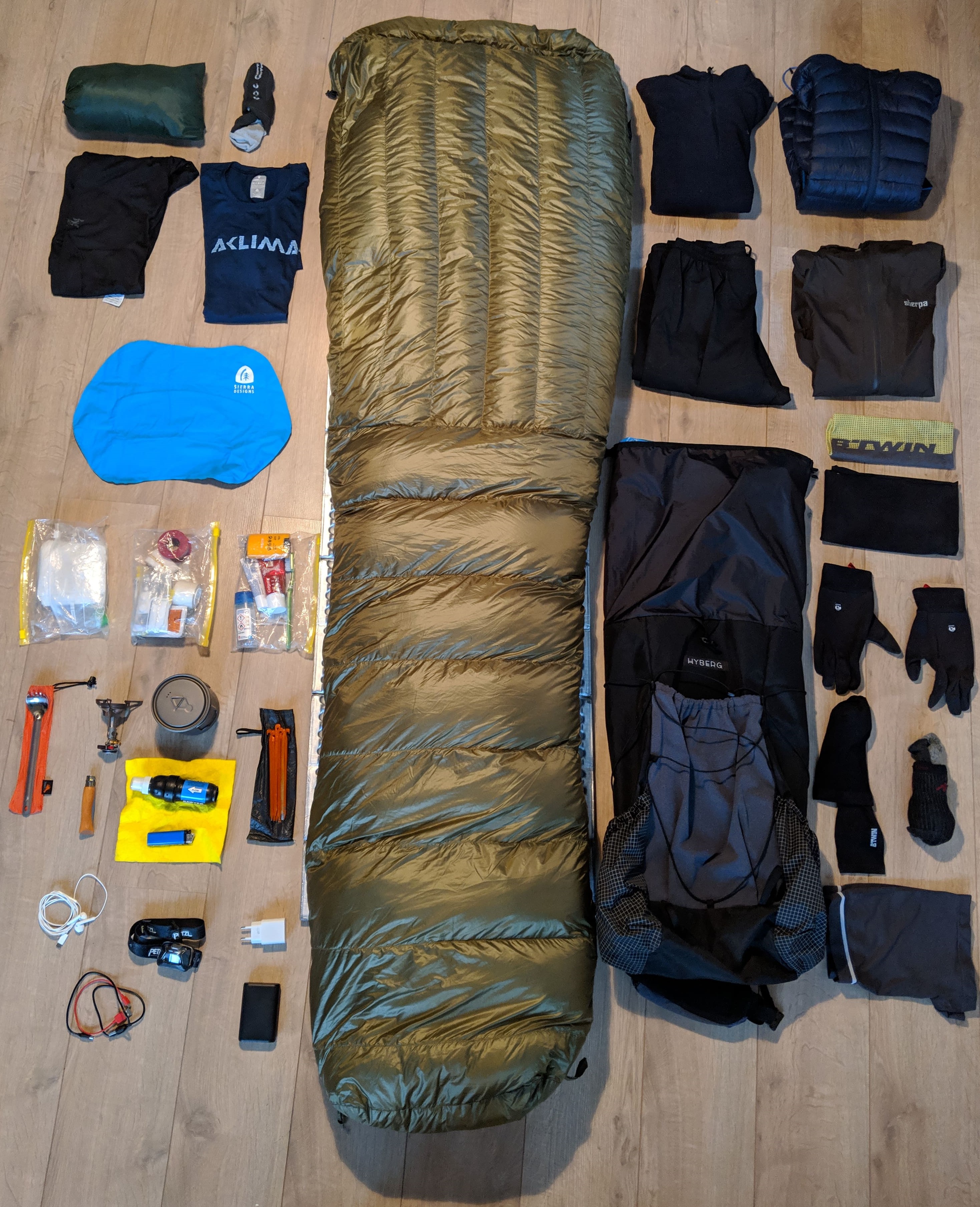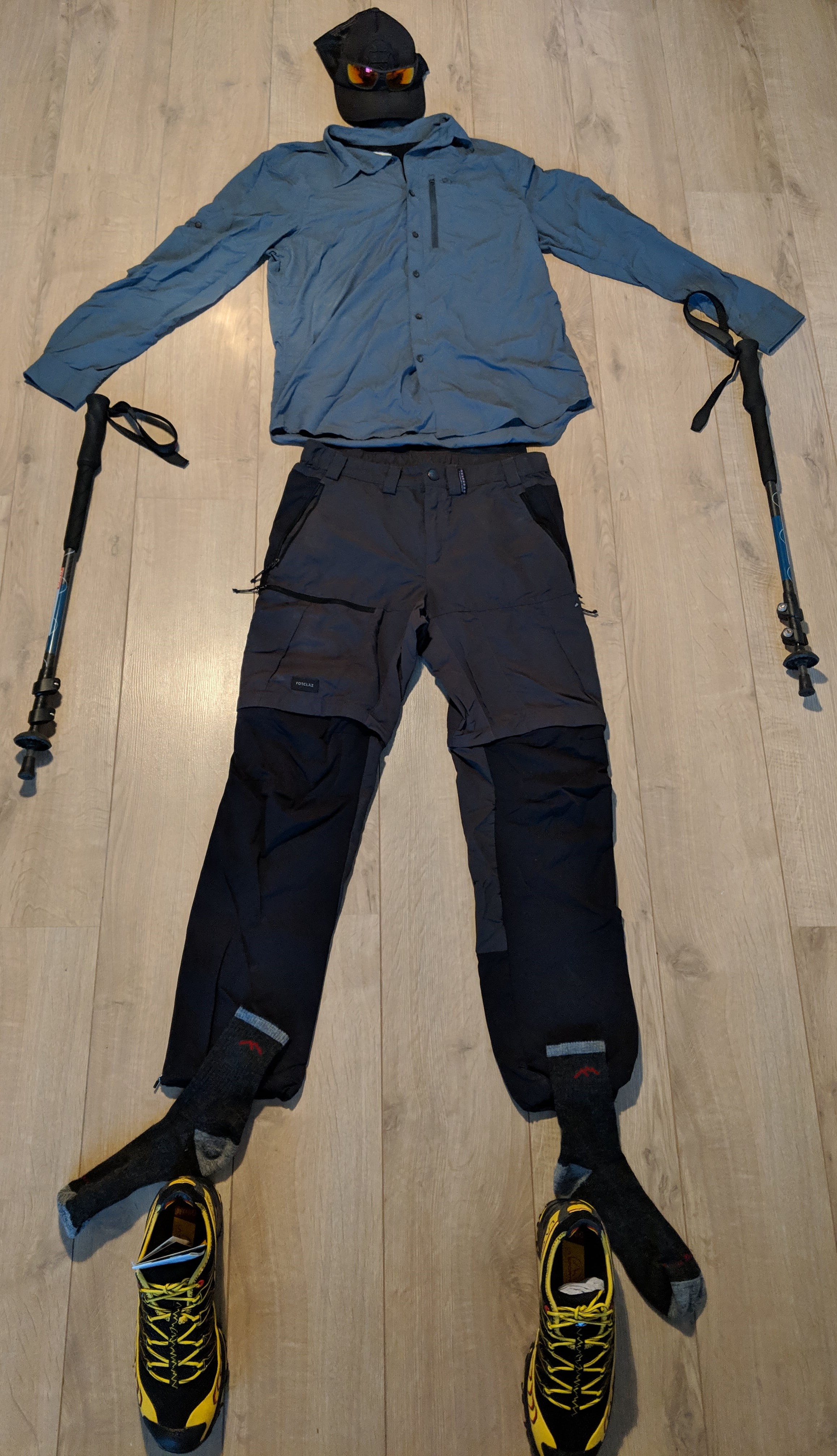Lightweight hiking & my gear for the Pacific Crest Trail

Lightweight hiking: that’s the trend in the US with regards to hiking. Although this trend has been going on for quite some time in the United States, it is found much less in Europe. While the classic image of the hiker with a 70-litre backpack and mountain boots is the standard in Europe, this is slowly shifting in America, mostly on the extreme long-distance hikes. This post describes my experience and development within lightweight hiking and discusses my gear list for the PCT.
Lightweight hiking is all about minimizing the weight of the gear that you carry on a hike as much as possible. The idea behind this is that there is less chance of injuries due to overloading, as less kilos are carried and supported by the shoulders, hips and back and less kilos are absorbed by the knees and feet. In addition, a lower packweight makes it possible to cover larger distances per day. The downside of this trend is that comfort is normally sacrificed for minimalist packing. Another point to take into account is that lightweight materials are generally less durable than their conventional and heavier counterpart. Lightweight gear can last for a long time, but more care and caution towards your equipment is needed to achieve this. Everyone has to make their own consideration between comfort, weight and durability of the equipment and balance this out.
Firstly, let’s take a look at some frequently used terms in lightweigt hiking:
- Baseweight: This is the holy grail of lightweight hiking. The baseweight includes the total weight of all the gear in your backpack, excluding consumables such as water, food and gas in a gas cartridge, as these variables can change per hike and per day. Also the clothes you’re wearing on you and, for example, trekking poles, when used, are not counted in the baseweight.
- Lightweight & ultralight: There are no hard rules and limits to what is considered lightweight and ultralight, but on several blogs and forums there seems to be consensus that a base weight of 20 pounds (lbs) (~9 kg) or lower is considered lightweight. A baseweight of 10 lbs/~4,5 kg or lower is considered ultralight (1 lbs is about 450 grams). However, since there are no fixed technical rules about this, it is definitely arbitrary and open for debate. At the end of the day, I don’t think it’s about getting the lightest pack on the world anyway. Rather it is about an individual journey to find your ideal trade-off between weight, comfort and durability and choose the accompanying gear to suit your needs. Whether this is ultralight, lightweight or conventional is irrelevant. Each category has its own advantages and each category allows you to complete a thru-hike.
- Big 3: This indicates the three largest and heaviest parts of the equipment: the backpack, the sleeping bag and the shelter (e.g. tent, tarp or hammock). Sometimes also the term Big 4 is coined. In addition to the three parts above, this also includes the sleeping pad. Since these are normally the heaviest items on your gear list, this also means that this is the gear where the most weight can be saved. A rule of thumb for a start in lightweight hiking is to get the Big 3 below three kilograms, which allows for a considerable reduction of one’s base weight.
After this short, theoretical introduction into the world of lightweight hiking, the focus now shifts to my personal experience and development within this niche. In my previous post I wrote how I’ve always been outdoors a lot, since my youngest years: I used to go for multi-day hiking trips regularly. These early experiences and previous hiking trips have taught me to pack quite minimalistic and basic for all my holidays in general and adventure/outdoor holidays in specific. Throughout all these years – from short multi-day hikes in the spring break to my first long summer holiday without my parents during which I carried everything I needed on my bicycle – I got to know myself and my needs more and more. I now know the gear I absolutely want to have with me, but also the gear I can live without. For example, last summer on my thru-hike of the Kungsleden in Sweden, I had a base weight of about 11 kg/24 lbs (estimated since I didn’t weigh the baseweight of my backpack at that time). This was the weight without consciously concerning myself and considering things like baseweight. I hadn’t even heard of baseweight yet. I just simply packed what I felt I needed.
After the Kungsleden I started to prepare more specifically and extensively for the Pacific Crest Trail and found out about lightweight hiking. At first I thought these lightweight hikers were all just a bunch of freaks that went very far just to lighten their load. This thought was further built on the fact that the trend of lightweight hiking is even more a niche market in Europe than it is in the USA and that lightweight gear is barely represented on trails and in outdoor stores here. However, the more I read and dived into the world of lightweight and ultralight hiking, the more enthusiastic I became. Furthermore, doing more research about the PCT led me to consider lightweight hiking as a serious option. Due to the fact that the PCT has various long dry sections through the desert, these sections would possibly require a water carry of up to 5 to 7 litres. Including carrying a couple of days worth of food, this could then quickly add 9-11 kg to your baseweight. Now that was a very good reason for me to lighten my pack more!
So I decided that I would go for lighter gear. I roamed the internet which taught me two things about lightweight hiking: the well-known, big brands don’t generally focus on lightweight hiking and secondly, lightweight hiking is mostly targeted toward and focused on the US market. In the USA there is a reasonable amount of so-called “cottage industries”, small-scale companies with a limited number of employees, to be found that provide the lightweight hiking community with high quality materials. Examples of such cottage industries, which are often also very engaged in the hiking community, include Zpacks, Hyperlite Mountain Gear, Waymark Gear Co. and Gossamer Gear. So there is plenty of gear in the US, but for Europeans this is not always a good option: import costs and extra taxes for the sometimes already expensive gear make such an investment not always worthwile. For me personally, the gear went from reasonably costly to unattractively expensive, which meant I went looking for European products. This was not always that easy, because the big majority of forums and reviews are discussing gear of the American cottage industries.
Anyway, I decided to focus first and foremost on reducing the weight of the big 3: the backpack, tent and sleeping bag. This is where I accomplished the biggest gain: I’ve always had a synthetic sleeping bag, a double-wall, two-person tent and a comfortable but rather heavy backpack. My big 3 for the start of the PCT consists of a lightweight backpack, a one-person, trekking pole tent and a down quilt. I will soon post a blog post in which I will explain more about a quilt and what the pros and cons of a quilt are.
This switch of the big 3 has yielded about a 3.5 kg (7.7 lbs) drop in my baseweight. This drop and my search for other gear online, led me to the conclusion that a baseweight of 6 kg (13.2 lbs) would be a reasonable and achievable target for me. This base weight would be considerably lighter than the base weight that I had, while I also wouldn’t have to make too many compromises about which gear to take: I wasn’t throwing too many items out of my pack, I was lightening up the items. With the Big 3’s weight gain behind me, it was now time to focus on the small items. It soon turned out that the weight of all the small gear items add up quickly too. Since the lightest option of any given item is to not take it with you on your hike, I went through all my gear from the Kungsleden and threw the unnecessary items out. Most of what I had taken with me, however, I thought was necessary, so eventually I ended up purchasing lighter options for most items. After a lot of weighing (literally and figuratively), I completed my quest for a sub-6 kg baseweight that I am satisfied with.
So you might wonder: “What are you taking on the trail then?” Let’s have a look. First of all my Big 4: from the traditional backpack I used during previous hikes, I switched to the Hyberg Attila: from 2.1 kg to 680 grams and from 65 litres to 55 litres. For the backpack, less volume is needed as there is less gear to carry and the lightweight gear is normally more compressible and less voluminous to pack. 55 litres is even quite spacious for my current gear, although it has the advantage that there is space for more gear/food for long sections or for a bear canister in the sections where this is required. This bear canister protects the food from bears, but is really bulky.
The second part of the Big 4 is the tent. I use the Trekkertent Stealth 1, a simple tent that is set up using trekking poles. Both trekking poles act in this case as tent poles during the night, so the weight of the tent only consists of the inner tent, outer tent and the stakes. This tent, including 8 stakes, weighs just under 800 grams, a gain of about 1200 grams compared to the previous tent I used.
Then there is the sleeping bag. I’ve always owned a synthetically insulated sleeping bag, but for the Pacific Crest Trail I switch to down. Down is warmer for its weight than synthetic insulation, so less down insulation is needed compared to a synthetic sleeping bag to achieve the same temperature ratings. The downside of down however, is that it loses some of its insulating qualities when wet. Thus it is important that the sleeping bag is prevented from getting wet as much as possible. In the end, for the PCT I chose a down quilt from Cumulus, the Cumulus Taiga 480 with 510 grams of down. This quilt has a comfort temperature rating of approximately -6°C/20°F. Compared to my old sleeping bag, the weight difference here is about halved: from 1650 grams to 840 grams (including the pad straps). Given the fact that the quilt is also warmer than my previous sleeping bag, this is a substantial gain.
Finally, the sleeping pad: the Thermarest Z-lite Sol. This is a reasonably comfortable foam pad with a higher R-value (warmer) than the regular Z-lite. The main reason I chose a foam pad is that it is care-free and leakproof. Especially during the first part of the PCT, where you hike through the desert, chances of a leak in an inflatable pad due to, for example, cactus spines, are present. Furthermore, a foam pad is quickly packed and unpacked during a break or at camp. The weight of the Z-lite Sol is 410 grams, which brings the total weight of my Big 4 to 2720 grams. Before my switch to lightweight, this was about 6300 grams.
If you are interested in my complete gear list, you can take a look at my lighterpack-page. Lighterpack is a website that can be used as an aid to reduce your base weight by clearly displaying each individual item on your gear list. Also, your base weight is calculated automatically.

Lastly, I have added some links below that discuss lightweight hiking. If you have become interested in lightweight hiking or want to know more about it, I recommend you take a look these websites:
https://www.rei.com/learn/expert-advice/ultralight-backpacking.html
https://en.wikipedia.org/wiki/Ultralight_backpacking
https://www.hyperlitemountaingear.com/pages/shakedown
Thanks for reading and see you next time!
Strooky
